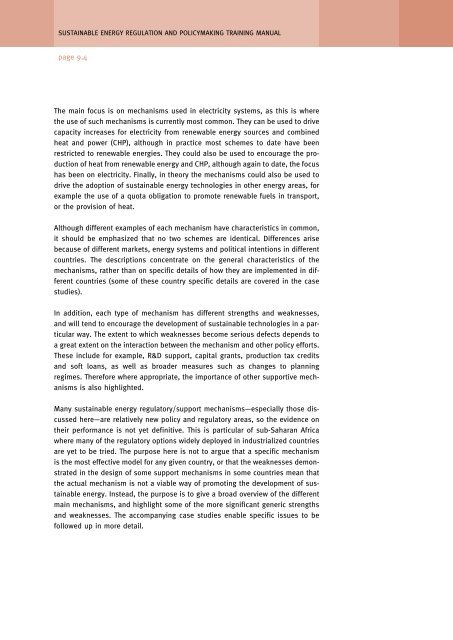Regulatory and policy options to encourage development of ...
Regulatory and policy options to encourage development of ...
Regulatory and policy options to encourage development of ...
- No tags were found...
Create successful ePaper yourself
Turn your PDF publications into a flip-book with our unique Google optimized e-Paper software.
SUSTAINABLE ENERGY REGULATION AND POLICYMAKING TRAINING MANUALpage 9.4The main focus is on mechanisms used in electricity systems, as this is wherethe use <strong>of</strong> such mechanisms is currently most common. They can be used <strong>to</strong> drivecapacity increases for electricity from renewable energy sources <strong>and</strong> combinedheat <strong>and</strong> power (CHP), although in practice most schemes <strong>to</strong> date have beenrestricted <strong>to</strong> renewable energies. They could also be used <strong>to</strong> <strong>encourage</strong> the production<strong>of</strong> heat from renewable energy <strong>and</strong> CHP, although again <strong>to</strong> date, the focushas been on electricity. Finally, in theory the mechanisms could also be used <strong>to</strong>drive the adoption <strong>of</strong> sustainable energy technologies in other energy areas, forexample the use <strong>of</strong> a quota obligation <strong>to</strong> promote renewable fuels in transport,or the provision <strong>of</strong> heat.Although different examples <strong>of</strong> each mechanism have characteristics in common,it should be emphasized that no two schemes are identical. Differences arisebecause <strong>of</strong> different markets, energy systems <strong>and</strong> political intentions in differentcountries. The descriptions concentrate on the general characteristics <strong>of</strong> themechanisms, rather than on specific details <strong>of</strong> how they are implemented in differentcountries (some <strong>of</strong> these country specific details are covered in the casestudies).In addition, each type <strong>of</strong> mechanism has different strengths <strong>and</strong> weaknesses,<strong>and</strong> will tend <strong>to</strong> <strong>encourage</strong> the <strong>development</strong> <strong>of</strong> sustainable technologies in a particularway. The extent <strong>to</strong> which weaknesses become serious defects depends <strong>to</strong>a great extent on the interaction between the mechanism <strong>and</strong> other <strong>policy</strong> efforts.These include for example, R&D support, capital grants, production tax credits<strong>and</strong> s<strong>of</strong>t loans, as well as broader measures such as changes <strong>to</strong> planningregimes. Therefore where appropriate, the importance <strong>of</strong> other supportive mechanismsis also highlighted.Many sustainable energy regula<strong>to</strong>ry/support mechanisms—especially those discussedhere—are relatively new <strong>policy</strong> <strong>and</strong> regula<strong>to</strong>ry areas, so the evidence ontheir performance is not yet definitive. This is particular <strong>of</strong> sub-Saharan Africawhere many <strong>of</strong> the regula<strong>to</strong>ry <strong>options</strong> widely deployed in industrialized countriesare yet <strong>to</strong> be tried. The purpose here is not <strong>to</strong> argue that a specific mechanismis the most effective model for any given country, or that the weaknesses demonstratedin the design <strong>of</strong> some support mechanisms in some countries mean thatthe actual mechanism is not a viable way <strong>of</strong> promoting the <strong>development</strong> <strong>of</strong> sustainableenergy. Instead, the purpose is <strong>to</strong> give a broad overview <strong>of</strong> the differentmain mechanisms, <strong>and</strong> highlight some <strong>of</strong> the more significant generic strengths<strong>and</strong> weaknesses. The accompanying case studies enable specific issues <strong>to</strong> befollowed up in more detail.










